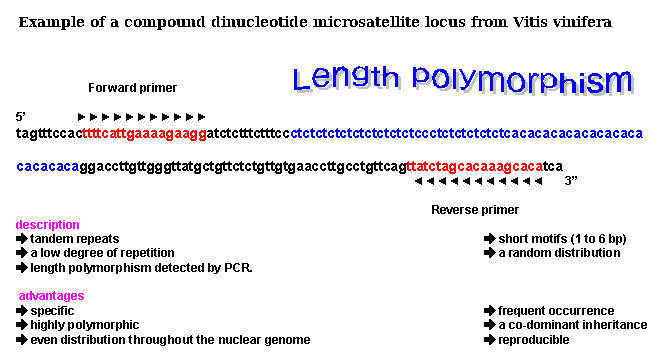Why a genetic database
The second step was the choice of the molecular markers to be used. This choice was oriented by the recent availability, at the time of undertaking this work, of microsatellite markers developed by the teams of Mark Thomas (CSIRO, Adelaide, Australia), Carole Meredith (University of California, Davis, USA) and Herta Steinkellner (University of Agriculture, Vienna, Austria) and by the set-up of the Vitis Microsatellite Consortium by the company Agrogene (France), which triggered an international effort of providing more microsatellite markers. People not familiar with microsatellites may consult the bibliography and the other links for useful reading.
Briefly,
microsatellites are DNA regions of the repeated DNA. They have the advantages
to be evenly scattered through the genome, to be present in thousands
of unique loci, which can be specifically amplified from their conserved
flanking regions. They are highly polymorphic which is the main required
feature of a good molecular marker, but they are also co-dominant, which
enables to discriminate homozygous and heterozygous states as well as
allowing to retrieve pedigrees. Finally they are widely viewed as selectively
neutral. From a technical point of view, if the development costs are
high, they are of an easy use and easy to standardize between different
laboratories which facilitates results comparison, provided allele sizing
has been previously standardised.

The use of microsatellite markers provides for the first time an estimation of genetic relationships between the Greek cultivars. The fact that we use SSR markers which have been used at the same time for analysing other European cultivars, make our results comparable to those of other European teams and allows comparison of genetic profiles between laboratories.
The results tables from the three genetic databases may be copied and pasted in an Excel worksheet for subsequent use with population genetics programmes.
The use of the databases content is free provided the source of information, that is to say the Greek Vitis Database is acknowledged as such (see Reference).
We hope that this Greek Vitis database will be a very practical tool for all scientists and other people interested in the Greek genetic resources of Vitis vinifera